-

人教版新目标初中英语九年级上册I like music that I can dance to教案
教学目标: 1. Express preferences2. Talk about one’s likes and dislikes and the reasons3. Learn to express one’s opinions 4. Learn to write a reply 语言功能: 1) Talk about one’s preferences, using t he relative clause2) Talk about people’s likes and dislikes and the reasons3) Talk about opinions语言结构: Relative clauses with that and who语言目标:What kind of music do you like?I like music that I can sing along with.I love singers who write their own music.We prefer music that has great lyric.重点词汇及短语:heart, photography, interest, class, whatever, miss, okay, expect, sweet, taste, itself, laboratory, cancer, increase, biscuit, main, care, prefer… to…, remind somebody of …, dance to, sing along with, be sure to, interest somebody, make somebody adj., to be honest, suit somebody, on display, catch up教学重难点:What do other people think of the different kinds of things? How to express one’s opinions? 学习方式:讨论,合作学习情感目标:通过本单元的学习,能提高学生的艺术鉴赏能力和审美情趣,并引导学生养成健康的饮食习惯。课时安排5课时第一课时:Section A: 1a-2c第二课时:Section A : 3a-4第三课时:Section B:1-2c, Self check2第四课时:Section B: 3a-4, Self check1第五课时:Self check ReadingI like music that I can dance to.

人教版新目标初中英语九年级上册I used to be afraid of the dark教案
内容提示1.本单元主要内容是学会used to结构。Used to +动词原形表示过去经常、以前常常,只用于过去式中,用来表示现在已不存在的习惯或状态。例如:They used to play football together.他们过去常在一起蹋足球。(现在不在一起踢了)2.used to的疑问形式和否定形式为Did you use to…?和I didn’t use to… 也可以用Used you to…?和I used not to…但现在多使用前者。例如:Did you used to swim in the river? 你过去常在河里游泳吗?I didn’t use to play the piano. 我以前并不经常弹钢琴。教学目标一、学习目标(Language Goal) 1.学会陈述自己过去常做的事情。2.学会陈述自己过去的爱好等。3.能够表达自己现在和过去在外表、性格、娱乐等方面的变化。4.能够表达朋友、家人等现在和过去的变化。二、语言结构(Language Structures) 1.I used to be short when I was young. 我年轻时个子很矮。 2. —Did you use to have straight hair? 你过去是直发吗?—Yes, I did. 是的。 3. —Did you use to play the piano? 你过去弹钢琴吗?—No, I didn’t. 不,我不弹。 4.I used to be afraid of dark. 我过去害怕黑暗。 5.I’m terrified of the snakes. 我害怕蛇。

人教版新目标初中英语九年级下册By the time I got outside, the bus had already left教案
Ⅰ. Teaching Aims and Demands1. Knowledge Objects(1) Key Vocabularyoversleep(2) Target LanguageWhat happened?I overslept. And by the time I got up, my brother had already gotten in the shower.2. Ability Objects(1) Teach the students to use the new words.(2) Train the students to narrate past events with the Past Perfect Tense.(3) Train the students' listening and speaking skills with the target language.3. Moral ObjectIt’s a good habit to go to bed early in the evening and get up early in the morning. So you’ll never be in a hurry in the morning.Ⅱ. Teaching Key Points1. Key Vocabularyoversleep2. Target LanguageNarrate past events with the Past Perfect TenseⅢ. Teaching Difficult Points1. Train the students to narrate past events with the Past Perfect Tense.2. Train the students to understand the target language in spoken conversation.Ⅳ. Teaching Methods1. Thinking of examples from the students' real lives.2. Making sentences by looking at the pictures.Ⅴ. Teaching AidA tape recorderⅥ. Teaching ProceduresStep I Revision1. Revise the language points in Unit 8.Ask some questions like this: What volunteer work would you like to do?Help the students to answer, I’d like to…/I love to…/I hope to2. Practice the dialogue in Activity 3c on page 62 again. Get students to role play the similar dialogues with the following.

人教版新目标初中英语九年级上册It must belong to Carla教案
一、Section A该部分有4个模块。第一模块围绕Whose volleyball is this? 这一话题展开思维( 1a)、听力(1b)、口语( 1c)训练;第二模块围绕上一模块中的话题进行听力( 2a-2b)、口语训练( 2c);第三模块继续围绕前两个模块中的“making inferences”展开训练。训练形式为阅读排序( 3a)和两人问答(3b);第四模块仍就上一话题展开讨论。二、Section B该部分有4个模块。第一模块要求根据图画和所提供的单词写出合理的句子;第二模块在听力( 2a-2b)和分角色口语训练( 2c)的基础上,继续进行“推测”训练; 第三模块围绕“Strange events in Bell Tower neighborhood”这一话题展开阅读( 3a)和写作(3b -3c)训练;第四模块以dream为话题展开小组活动。三、Self Check该部分有3个模块。第一模块以填空形式对所学词汇进行训练;第二模块就8个谚语展开阅读和讨论。

人教版新目标初中英语九年级下册Could you please tell me where the restrooms are教案
Step Ⅰ RevisionCheck homework. Ask a few students to read the article in 3a.Then ask a few students to read their guides.Step Ⅱ Part 1Look at the words in the box. Ask a student to read them. Make sure the students understand the meaning of the words. You are to fill in the blanks with the words. In some cases, students may need to use another form of the word, for example adjusting for tense or subject/ verb agreement.Ask students to fill in the blanks on their own.Check the answers. Step ⅢPart 2Go through the instructions with the class.Look at the example with the students.Ask students what the answer would be.Ask a student to read the question and answer it.Excuse me, could you tell me where the bank is, please?The bank is across the street from the shopping malt.Get students to complete the work in pairs.Check the answers. Ask a few students to read their questions.Step Ⅳ Just for Fun!Ask all the students to read the conversation. Ask: What is funny about this cartoon? Help students to explain. A Martian is a person from the planet Mars.There is no such thing as Martian food on Earth, and the clerk looks silly because he is trying to think of where there is a Martian restaurant.Invite some pairs of students to present this conversation to the rest of the class.Step Ⅴ Summary and HomeworkIn this class, we’ve done much writing practice using the key vocabulary words and the target language presented in this unit. After class, please finish the questions in 2 in your exercise books. Then finish the exercises on pages 47~48 of the workbook as well.The Seventh Period Ⅰ Teaching Aims and Demands1. Knowledge Objects(1) Key Vocabularyimage, adventure, jealousy, hero, crime, journey, brave, no longer, show interest in, take it easy, become interested in, plain looks(2)Text:Grown-ups like cartoons, too.2. Ability Objects(1) Fast-reading to get a general idea of the text.(2) Careful-reading to get the detailed information in the text.

人教版新目标初中英语九年级下册I’ll help clean up the city parks教案
Talk about offering help (P60)I’ll help clean up the city parks.A: I’d like to work ...B: You could help ...Talk about ways to tell people about the Clean-Up Day (P61)We need to ...We can’t ...I’ll ...Talk about the work the volunteers do (P62)These three students all volunteer their time to help other people.Somebody loves to ... / helps ... / plans to ... / wants to ...A: What do you like doing?B: I like ... A: What kind of volunteer work do you think I could do?B: You could ...1. 重点词汇advertisement, fix, repair, pleasure, blind, deaf, shut, carry, specially, fetch2. 认读词汇hunger, homeless, cheer, clean-up, sign, establish, major, commitment, elementary, veterinarian, coach, similar, call-in, strategy, disabled, organization, unable, support, appreciate, donation, part of speech, pronoun, adverb, preposition, conjunction, donate, Jimmy, Sally3. 词组clean up, cheer up, give out, put off, set up, think up, take after, fix up, give away, put up, hand out, work out, at once

人教版新目标初中英语九年级下册You’re supposed to shake hands教案
教学目标:1. 掌握本单元一些重点词汇的写法和用法。2. 学会自如谈论餐桌礼仪。Step 1 RevisionAsk some students to retell the customs at the table in France in the passage in 3a.Step 2 Self checkPart 1. Fill in each bland with the correct word given. Students do the exercises by themselves at first. Then check the answers. Ask the students to comprehend the sentences and help them point out uses of some words, like “arrive (at / in) sw., spend time / money on sth , spend time / money (in) doing sth.”Part 2. Read about Fan Ling’s experience in a western restaurant. Understand the passage. Point out some key points in the passage.1. be / get used to doing sth. 习惯做某事2. begin with = start with 以….开头3. crowd v. 挤满,塞满 the crowd 人群 crowded adj. 拥挤的Then students discuss about how she would solve her problem. Ask some to share their stories with others.Part 3. Complete the crossword by looking at the sentences on the left. Then check the answers.
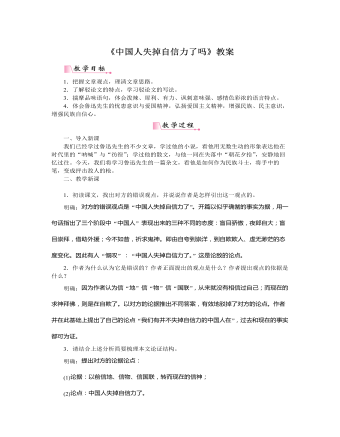
部编版语文九年级上册《中国人失掉自信力了吗》教案
一、导入新课我们已经学过鲁迅先生的不少文章,学过他的小说,看他用无数生动的形象表达他在时代里的“呐喊”与“彷徨”;学过他的散文,与他一同在失落中“朝花夕拾”,安静地回忆过往。今天,我们将学习鲁迅先生的一篇杂文,看他是如何作为民族斗士,将手中的笔,变成抨击敌人的枪。二、教学新课目标导学一:学习驳论,理清思路1.初读课文,找出对方的错误观点,并说说作者是怎样引出这一观点的。明确:对方的错误观点是“中国人失掉自信力了”。开篇以似乎确凿的事实为据,用一句话指出了三个阶段中“中国人”表现出来的三种不同的态度:盲目骄傲,夜郎自大;盲目崇拜,借助外援;今不如昔,祈求鬼神。即由自夸到崇洋,到自欺欺人、虚无渺茫的态度变化。因此有人“慨叹”:“中国人失掉自信力了。”这是论敌的论点。
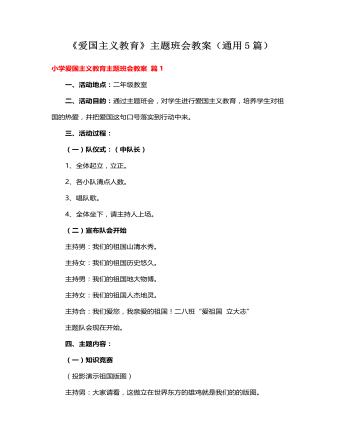
《爱国主义教育》主题班会教案(通用5篇)
我是中国人民的儿子。我深情地爱着我的祖国和人民。爱国主义是千百年来巩固与发展起来的对自己的祖国的一种最深厚的感情。 列宁为什么我的眼里常含着泪水?因为我对这土地爱得深沉! 艾青【第四环节:演唱爱国歌曲】主持人:下面请几位同学为我们展示自己的精彩才艺。演唱一首爱国主题歌曲,让我们在激荡人心的歌声中结束我们这次的主题班会。演唱曲目《爱我中华》主持人:在美妙的歌声中,本次主题班会到此结束。活动小结:通过这次主题班会,激发了学生的爱国情感和民族自豪感,也更加让同学们体会到祖国的发展与强大与同学们是息息相关的,使同学们体会到了肩上所承担的重任让他们明白为什么爱国以及作为学生该如何爱国,将主题班会内容内化到他们的思想中,落实到他们的行动中去。
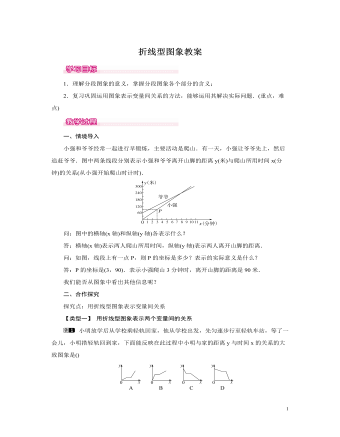
北师大初中七年级数学下册折线型图象教案
解析:(1)根据图象的纵坐标,可得比赛的路程.根据图象的横坐标,可得比赛的结果;(2)根据乙加速后行驶的路程除以加速后的时间,可得答案.解:(1)由纵坐标看出,这次龙舟赛的全程是1000米;由横坐标看出,乙队先到达终点;(2)由图象看出,相遇是在乙加速后,加速后的路程是1000-400=600(米),加速后用的时间是3.8-2.2=1.6(分钟),乙与甲相遇时乙的速度600÷1.6=375(米/分钟).方法总结:解决双图象问题时,正确识别图象,弄清楚两图象所代表的意义,从中挖掘有用的信息,明确实际意义.三、板书设计1.用折线型图象表示变量间关系2.根据折线型图象获取信息解决问题经历一般规律的探索过程,培养学生的抽象思维能力,经历从实际问题中得到关系式这一过程,提升学生的数学应用能力,使学生在探索过程中体验成功的喜悦,树立学习的自信心.体验生活中数学的应用价值,感受数学与人类生活的密切联系,激发学生学数学、用数学的兴趣
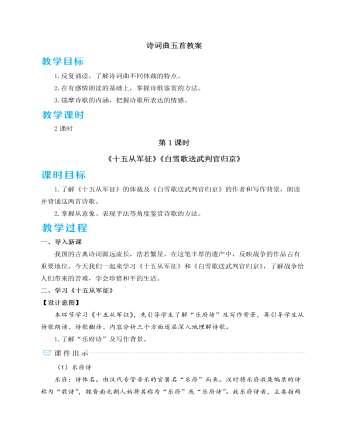
人教部编版语文九年级下册诗词曲五首教案
2.了解“散曲”。散曲:到了元代,出现新兴的体裁——曲。曲大致分为两种,一是剧曲,一是散曲。散曲没有动作、说白,包括套数和小令两种基本形式。套数由若干曲子组成,小令以一支曲子为独立单位。《天净沙·秋思》《山坡羊·潼关怀古》都是有标题的小令。本篇“山坡羊”是小令的曲牌名,“潼关怀古”是标题。3.品读曲词,把握诗歌内容与情感。(1)反复朗读课文,说说这首小令根据内容可以分为几层,每一层写的是什么内容。预设 共写了三层。第一层:“峰峦如聚……山河表里潼关路。”写潼关地势险要,是历代兵家必争之地。第二层:“望西都……宫阙万间都做了土。”由潼关的险要地势想到其重要的历史作用及曾建都长安的历代王朝,抒发怀古情思。第三层:“兴,百姓苦;亡,百姓苦。”从对现实场景的描写转入议论抒情,诗人通过对历史清醒的认识,对老百姓的疾苦感到无比愤慨和深切同情。
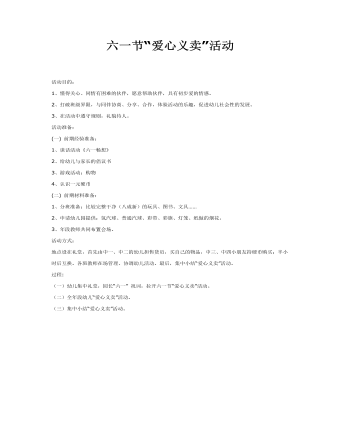
中班社会:六一节“爱心义卖”活动课件教案
2、打破班级界限,与同伴协商、分享、合作,体验活动的乐趣,促进幼儿社会性的发展。3、在活动中遵守规则,礼貌待人。活动准备:(一) 前期经验准备:1、谈话活动《六一畅想》2、给幼儿与家长的倡议书3、游戏活动:购物4、认识一元硬币
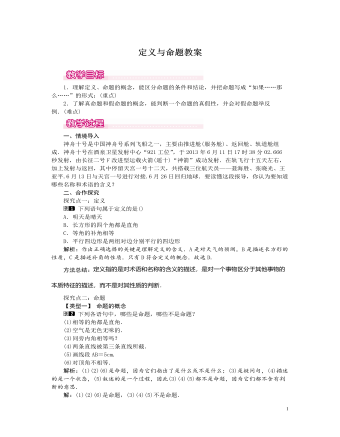
北师大初中数学八年级上册定义与命题1教案
一、情境导入神舟十号是中国神舟号系列飞船之一,主要由推进舱(服务舱)、返回舱、轨道舱组成.神舟十号在酒泉卫星发射中心“921工位”,于2013年6月11日17时38分02.666秒发射,由长征二号F改进型运载火箭(遥十)“神箭”成功发射.在轨飞行十五天左右,加上发射与返回,其中停留天宫一号十二天,共搭载三位航天员——聂海胜、张晓光、王亚平.6月13日与天宫一号进行对接.6月26日回归地球.要读懂这段报导,你认为要知道哪些名称和术语的含义?二、合作探究探究点一:定义 下列语句属于定义的是()A.明天是晴天B.长方形的四个角都是直角C.等角的补角相等D.平行四边形是两组对边分别平行的四边形解析:作出正确选择的关键是理解定义的含义.A是对天气的预测,B是描述长方形的性质,C是描述补角的性质.只有D符合定义的概念.故选D.方法总结:定义指的是对术语和名称的含义的描述,是对一个事物区分于其他事物的本质特征的描述,而不是对其性质的判断.
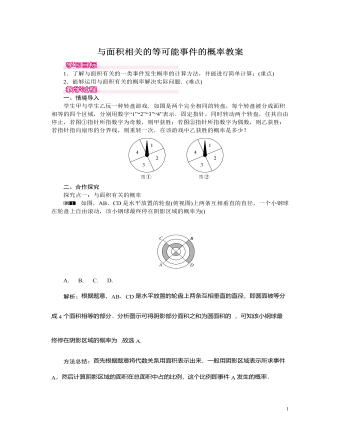
北师大初中七年级数学下册与面积相关的等可能事件的概率教案
方法总结:当某一事件A发生的可能性大小与相关图形的面积大小有关时,概率的计算方法是事件A所有可能结果所组成的图形的面积与所有可能结果组成的总图形面积之比,即P(A)=事件A所占图形面积总图形面积.概率的求法关键是要找准两点:(1)全部情况的总数;(2)符合条件的情况数目.二者的比值就是其发生的概率.探究点二:与面积有关的概率的应用如图,把一个圆形转盘按1∶2∶3∶4的比例分成A、B、C、D四个扇形区域,自由转动转盘,停止后指针落在B区域的概率为________.解析:∵一个圆形转盘按1∶2∶3∶4的比例分成A、B、C、D四个扇形区域,∴圆形转盘被等分成10份,其中B区域占2份,∴P(落在B区域)=210=15.故答案为15.三、板书设计1.与面积有关的等可能事件的概率P(A)= 2.与面积有关的概率的应用本课时所学习的内容多与实际相结合,因此教学过程中要引导学生展开丰富的联想,在日常生活中发现问题,并进行合理的整合归纳,选择适宜的数学方法来解决问题
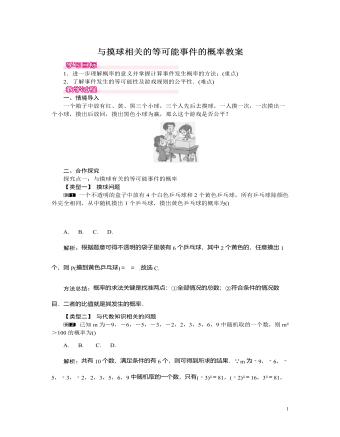
北师大初中七年级数学下册与摸球相关的等可能事件的概率教案
1.进一步理解概率的意义并掌握计算事件发生概率的方法;(重点)2.了解事件发生的等可能性及游戏规则的公平性.(难点)一、情境导入一个箱子中放有红、黄、黑三个小球,三个人先后去摸球,一人摸一次,一次摸出一个小球,摸出后放回,摸出黑色小球为赢,那么这个游戏是否公平?二、合作探究探究点一:与摸球有关的等可能事件的概率【类型一】 摸球问题一个不透明的盒子中放有4个白色乒乓球和2个黄色乒乓球,所有乒乓球除颜色外完全相同,从中随机摸出1个乒乓球,摸出黄色乒乓球的概率为()A.23 B.12 C.13 D.16解析:根据题意可得不透明的袋子里装有6个乒乓球,其中2个黄色的,任意摸出1个,则P(摸到黄色乒乓球)=26=13.故选C.方法总结:概率的求法关键是找准两点:①全部情况的总数;②符合条件的情况数目.二者的比值就是其发生的概率.【类型二】 与代数知识相关的问题已知m为-9,-6,-5,-3,-2,2,3,5,6,9中随机取的一个数,则m4>100的概率为()A.15 B.310 C.12 D.35

北师大初中八年级数学下册三角形的全等和等腰三角形的性质教案
证明:过点A作AF∥DE,交BC于点F.∵AE=AD,∴∠E=∠ADE.∵AF∥DE,∴∠E=∠BAF,∠FAC=∠ADE.∴∠BAF=∠FAC.又∵AB=AC,∴AF⊥BC.∵AF∥DE,∴DE⊥BC.方法总结:利用等腰三角形“三线合一”得出结论时,先必须已知一个条件,这个条件可以是等腰三角形底边上的高,可以是底边上的中线,也可以是顶角的平分线.解题时,一般要用到其中的两条线互相重合.三、板书设计1.全等三角形的判定和性质2.等腰三角形的性质:等边对等角3.三线合一:在等腰三角形的底边上的高、中线、顶角的平分线中,只要知道其中一个条件,就能得出另外的两个结论.本节课由于采用了动手操作以及讨论交流等教学方法,有效地增强了学生的感性认识,提高了学生对新知识的理解与感悟,因而本节课的教学效果较好,学生对所学的新知识掌握较好,达到了教学的目的.不足之处是少数学生对等腰三角形的“三线合一”性质理解不透彻,还需要在今后的教学和作业中进一步巩固和提高
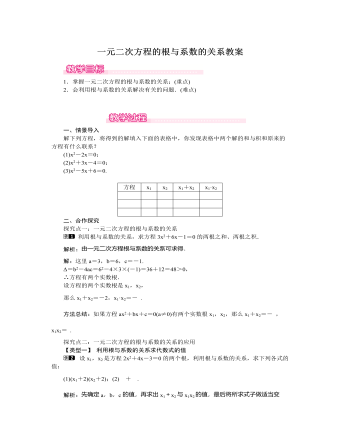
北师大初中数学九年级上册一元二次方程的根与系数的关系1教案
方程有两个不相等的实数根.综上所述,m=3.易错提醒:本题由根与系数的关系求出字母m的值,但一定要代入判别式验算,字母m的取值必须使判别式大于0,这一点很容易被忽略.三、板书设计一元二次方程的根与系数的关系关系:如果方程ax2+bx+c=0(a≠0) 有两个实数根x1,x2,那么x1+x2 =-ba,x1x2=ca应用利用根与系数的关系求代数式的值已知方程一根,利用根与系数的关系求方程的另一根判别式及根与系数的关系的综合应用让学生经历探索,尝试发现韦达定理,感受不完全的归纳验证以及演绎证明.通过观察、实践、讨论等活动,经历发现问题、发现关系的过程,养成独立思考的习惯,培养学生观察、分析和综合判断的能力,激发学生发现规律的积极性,激励学生勇于探索的精神.通过交流互动,逐步养成合作的意识及严谨的治学精神.
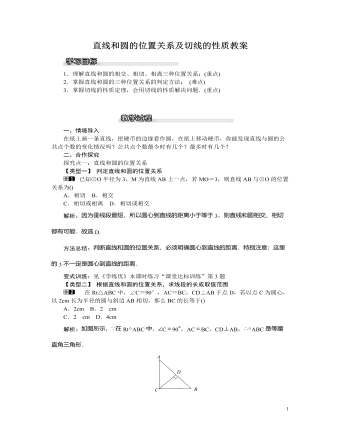
北师大初中九年级数学下册直线和圆的位置关系及切线的性质教案
解析:(1)由切线的性质得AB⊥BF,因为CD⊥AB,所以CD∥BF,由平行线的性质得∠ADC=∠F,由圆周角定理的推论得∠ABC=∠ADC,于是证得∠ABC=∠F;(2)连接BD.由直径所对的圆周角是直角得∠ADB=90°,因为∠ABF=90°,然后运用解直角三角形解答.(1)证明:∵BF为⊙O的切线,∴AB⊥BF.∵CD⊥AB,∴∠ABF=∠AHD=90°,∴CD∥BF.∴∠ADC=∠F.又∵∠ABC=∠ADC,∴∠ABC=∠F;(2)解:连接BD,∵AB为⊙O的直径,∴∠ADB=90°,∴∠A+∠ABD=90°.由(1)可知∠ABF=90°,∴∠ABD+∠DBF=90°,∴∠A=∠DBF.又∵∠A=∠C,∴∠C=∠DBF.在Rt△DBF中,sin∠DBF=sinC=35,DF=6,∴BF=10,∴BD=8.在Rt△ABD中,sinA=sinC=35,BD=8,∴AB=403.∴⊙O的半径为203.方法总结:运用切线的性质来进行计算或论证,常通过作辅助线连接圆心和切点,利用垂直构造直角三角形解决有关问题.
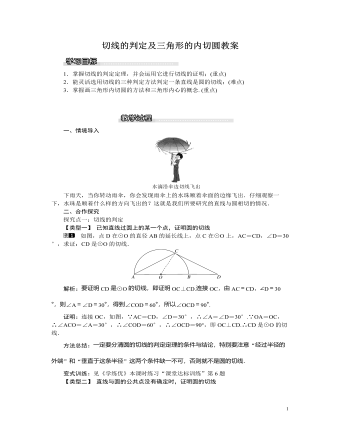
北师大初中九年级数学下册切线的判定及三角形的内切圆教案
解析:(1)连接BI,根据I是△ABC的内心,得出∠1=∠2,∠3=∠4,再根据∠BIE=∠1+∠3,∠IBE=∠5+∠4,而∠5=∠1=∠2,得出∠BIE=∠IBE,即可证出IE=BE;(2)由三角形的内心,得到角平分线,根据等腰三角形的性质得到边相等,由等量代换得到四条边都相等,推出四边形是菱形.解:(1)BE=IE.理由如下:如图①,连接BI,∵I是△ABC的内心,∴∠1=∠2,∠3=∠4.∵∠BIE=∠1+∠3,∠IBE=∠5+∠4,而∠5=∠1=∠2,∴∠BIE=∠IBE,∴BE=IE;(2)四边形BECI是菱形.证明如下:∵∠BED=∠CED=60°,∴∠ABC=∠ACB=60°,∴BE=CE.∵I是△ABC的内心,∴∠4=12∠ABC=30°,∠ICD=12∠ACB=30°,∴∠4=∠ICD,∴BI=IC.由(1)证得IE=BE,∴BE=CE=BI=IC,∴四边形BECI是菱形.方法总结:解决本题要掌握三角形的内心的性质,以及圆周角定理.
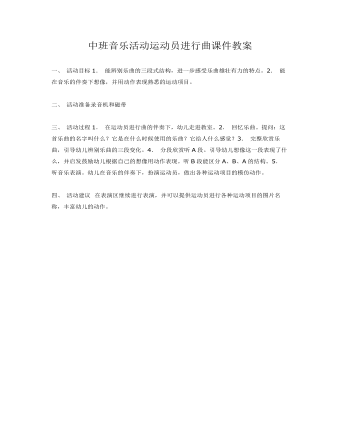
中班音乐活动运动员进行曲课件教案
二、活动准备录音机和磁带三、活动过程1.在运动员进行曲的伴奏下,幼儿走进教室。2.回忆乐曲。提问:这首乐曲的名字叫什么?它是在什么时候使用的乐曲?它给人什么感觉?3.完整欣赏乐曲,引导幼儿辨别乐曲的三段变化。
